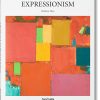Abstract Expressionism Taschen Basic
$20.00
![]() Free shipping within 3 days
Free shipping within 3 days
![]() Easy returns within 30 days
Easy returns within 30 days
![]() Shopping information security
Shopping information security
Only 17 left, hurry up.

Shipping is not available in Belgium.
$20.00
![]() Free shipping within 3 days
Free shipping within 3 days
![]() Easy returns within 30 days
Easy returns within 30 days
![]() Shopping information security
Shopping information security


Reviews
There are no reviews yet.